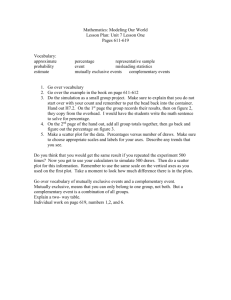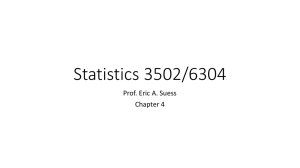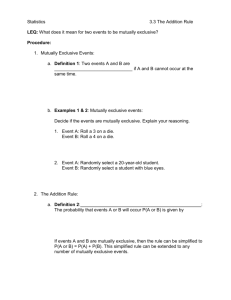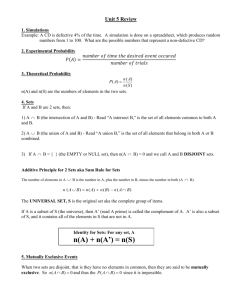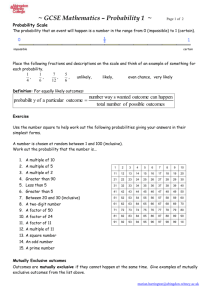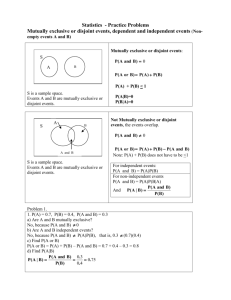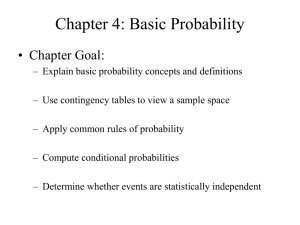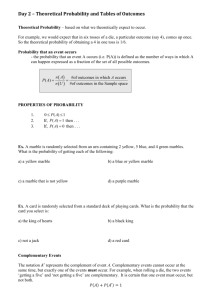A∩ B
advertisement
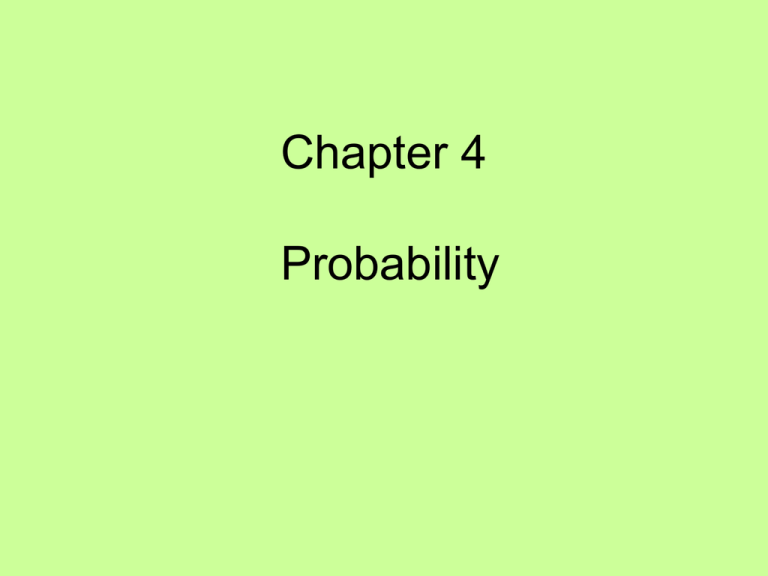
Chapter 4 Probability Probability Defined A probability is a number between 0 and 1 that measures the chance or likelihood that some event or set of events will occur. Assigning Basic Probabilities • Classical Approach • Relative Frequency Approach • Subjective Approach Classical Approach F P(A) = T where P(A) = probability of event A F = number of outcomes “favorable” to event A T = total number of outcomes possible in the experiment Relative Frequency Approach n P(A) = N where N = total number of observations or trials n = number of times that event A occurs The Language of Probability • • • • • • Simple Probability Conditional Probability Independent Events Joint Probability Mutually Exclusive Events Either/Or Probability Statistical Independence Two events are said to be statistically independent if the occurrence of one event has no influence on the likelihood of occurrence of the other. Statistical Independence P(A l B) = P(A) “given” and (4.1) P (B l A) = P(B) “given” General Multiplication Rule P(A B) = P(A)∙ P(BlA) “and” (4.2) Multiplication Rule for Independent Events P(A B) = P(A) ∙P(B) (4.3) Mutually Exclusive Events Two events, A and B, are said to be mutually exclusive if the occurrence of one event means that the other event cannot or will not occur. Mutually Exclusive Events P(A B) = 0 (4.4) General Addition Rule (4.5) P(A B) = P(A) + P(B) - P(A B) “or” Addition Rule for Mutually Exclusive Events P(A B) = P(A) + P(B) (4.6) “Conditional Equals JOINT Over SIMPLE” Rule P( A B) P(B I A) = P( A) P(A I B) = P ( A B ) P( B) (4.7a) (4.7b) Complementary Events Rule P(A′ ) = 1 – P(A) (4.8) Figure 4.1 Venn Diagram for the Internet Shoppers Example Sample Space (1.0) A(.8) B(.6) (Airline Ticket Purchase) (Book Purchase) A∩ B (.5) The sample space contains 100% of the possible outcomes in the experiment. 80% of these outcomes are in Circle A; 60% are in Circle B; 50% are in both circles. Figure 4.2 Complementary Events Sample Space (1.0) A A’ (.2) .8 (everything in the sample space outside A) The events A and A’ are said to be complementary since one or the other (but never both) must occur. For such events, P(A’ ) = 1 - P(A). Figure 4.3 Mutually Exclusive Events Sample Space (1.0) A B Mutually exclusive events appear as non-overlapping circles in a Venn diagram. Figure 4.4 Probability Tree for the Project Example STAGE 1 PROJECT A PERFORMANCE STAGE 2 PROJECT B PERFORMANCE B A A is under budget B is under budget B' B is not under budget B A' A is not under budget B is under budget B' B is not under budget Figure 4.5 Showing Probabilities on the Tree STAGE 1 PROJECT A PERFORMANCE STAGE 2 PROJECT B PERFORMANCE B(.6) A (.25) A is under budget B is under budget B‘(.4) B is not under budget B(.2) A‘(.75) A is not under budget B is under budget B‘(.8) B is not under budget Figure 4.6 Identifying the Relevant End Nodes On The Tree STAGE 1 PROJECT A PERFORMANCE STAGE 2 PROJECT B PERFORMANCE B(.6) A (.25) A is under budget (1) B is under budget B‘(.4) (2) B is not under budget B(.2) A‘(.75) A is not under budget B is under budget B‘(.8) B is not under budget (3) (4) Figure 4.7 Calculating End Node Probabilities STAGE 1 PROJECT A PERFORMANCE STAGE 2 PROJECT B PERFORMANCE B(.6) A (.25) A is under budget B is under budget B‘(.4) (1) (2) .10 B is not under budget B(.2) A‘(.75) A is not under budget B is under budget B‘(.8) B is not under budget (3) (4) .15 Figure 4.8 Probability Tree for the Spare Parts Example SOURCE CONDITION B (.04) A (.7) 1 Adams is the supplier Unit is defective B' (.96) Unit is OK B (.07) A 2 (.3) Alder is the supplier Unit is defective B' (.93) Unit is OK Figure 4.9 Using the Tree to Calculate End-Node Probabilities SOURCE CONDITION B (.04) A 1 (.7) Adams is the supplier Unit is defective .028 .021 B' (.96) Unit is OK B (.07) A 2 (.3) Unit is defective Alder is the supplier B' (.93) Unit is OK Bayes’ Theorem (Two Events) P( A1 ) P( B / A1 ) P(A1 l B) = P( A1 ) P( B / A1 ) P( A2 ) P( B / A2 ) (4.9) General Form of Bayes’ Theorem P( Ai ) P( B / Ai ) P(Ai l B) = P( A1 ) P( B / A1 ) P( A2 ) P( B / A2 ) ... P( Ak ) P( B / Ak ) Cross-tabs Table Under Grad Very Important Important Not Important 80 60 40 180 100 50 70 220 180 110 110 400 Grad Joint Probability Table Very Important Important Not Important Under Grad .20 .15 .10 .45 Grad .25 .125 .175 .55 .45 .275 .275 1.00 Counting Total Outcomes (4.10) in a Multi-Stage Experiment Total Outcomes = m1 x m2 x m3 x…x mk where mi = number of outcomes possible in each stage k = number of stages Combinations (4.11) n! nCx = (n x)!x! where = number of combinations (subgroups) of n objects selected x at a time n = size of the larger group x = size of the smaller subgroups nCx Figure 4.10 Your Car and Your Friends Friends 2 3 A B E 1 4 C D Car Five friends are waiting for a ride in your car, but only four seats are available. How many different arrangements of friends in the car are possible? Permutations n! nPx = (n x )! (4.12)

